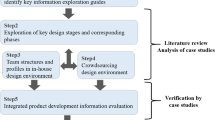Abstract
To reduce “time-to-market”, semantics of a product must be synchronized in a design chain, because inconsistencies during collaborative product development cause an unnecessary waste of time. To guarantee semantic synchronization, all enterprises should co-operate and maintain semantics whenever they are updated. In this paper, a V2-model is proposed to share product semantics during collaborative product development through view-based semantic synchronization. The V2-model has two kinds of model layers for semantic synchronization: a view-independent model (VIM) layer and a view-specific model (VSM) layer. Semantics in the VIM is the well-structured semantics shared among all enterprises and thus are published across the collaborative design chain. On the other hand, semantics in the VSM is the inconsistent semantics for product information that occurs during the early design stage, when different enterprises may have differing views about product concepts that are constructs of semantics. The inconsistencies between the different views can be solved by a decision and sharing (DnS) process and V2-model. The DnS process transforms the concepts in the VSM to the concepts in the VIM by utilizing topic maps-based sco** and merging functions. The proposed V2-model has been successfully applied to the design process of a washing machine model.
Similar content being viewed by others
References
Younghwan C, Kwangsoo K, Cheolhan K (2005) A design chain collaboration framework using reference models. Int J Adv Manuf Technol 26(1):183–190
Jagdev HS, Thoben KD (2001) Anatomy of enterprise collaboration. Prod Plan Control 12(5):421–436
Perrin O, Godart C (2004) A model to support collaborative work in virtual enterprises. Data Knowl Eng 50(1):63–86
O’Marah K (2002) PDM+ERP=PLM: TIBCO and PTC join to make this a little easier. AMR Res Alert, 8 Feb 2002
Pouchard L, Ivezic N, Schlenoff C (2000) Ontology engineering for distributed collaboration in manufacturing. Proc AIS2000 Conference
Myriam R, Dieng-Kuntz R (2002) A view model for cooperative building of an ontology. ICCS 2002, LNAI2393
Ulrich KT, Ep**er SD (1995) Product design and development. McGraw-Hill, New York
Members of the TopicMaps.Org authoring group (2001) XML topic maps (XTM) 1.0. http://Topicmaps.org/xtm/
OMG (2002) Meta object facility (MOF) specification. http://www.omg.org/docs/formal/02-04-03.pdf
OMG (2001) OMG unified modeling language specification. http://www.omg.org/docs/formal/01-09-67.pdf
Marino O, Rechenmann F, Uvietta P (1990) Multiple perspectives and classification mechanism in object-oriented representation. Proc. 9th ECAI, Stockholm, Sweden, Pitman Publishing, London, pp 425–430
Dekker L, Carre B (1992) Multiple and dynamic representation of frames with points of view in FROME. Proc. RPO’92. La Grande Motte, France
Author information
Authors and Affiliations
Corresponding author
Rights and permissions
About this article
Cite this article
Chae, H., Kim, K., Choi, Y. et al. A view-based approach to modeling product semantics in design chains. Int J Adv Manuf Technol 32, 863–876 (2007). https://doi.org/10.1007/s00170-006-0419-4
Received:
Accepted:
Published:
Issue Date:
DOI: https://doi.org/10.1007/s00170-006-0419-4




